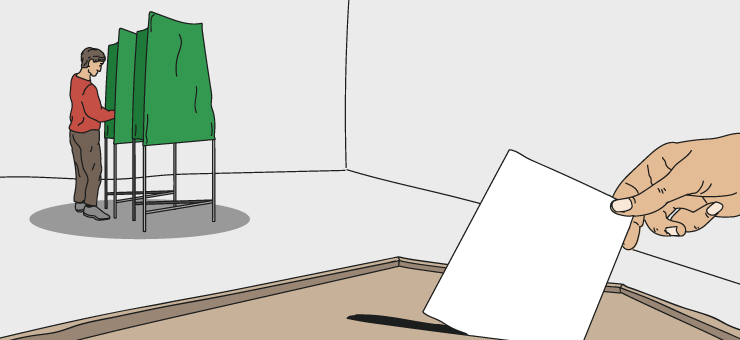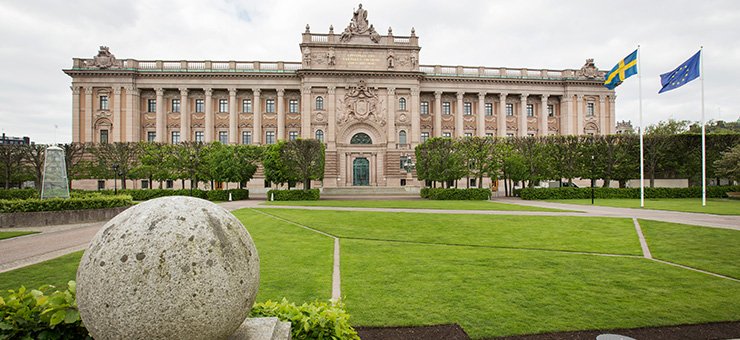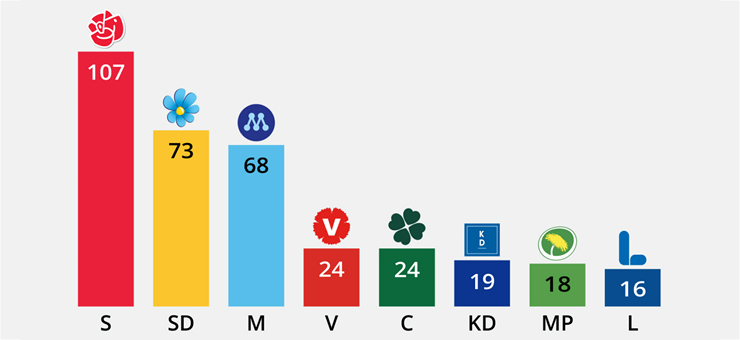The Swedish electoral system
Last updated: 3/7-2023
This text is about the Swedish electoral system. It is through elections that the population can influence policymaking in Sweden.

The text includes descriptions of the elections held in Sweden, who can vote in them and how you go about voting. It also talks about who can become a politician and who governs Sweden today.
Everyone has the right to participate in the governing of their country, either directly or by electing their representatives in free and fair elections.
You are also entitled to freedom of opinion and expression. This means that you are free to have the views and think the thoughts you wish. You can also spread your ideas and thoughts to others, such as via social media. But you are not allowed to use your freedom of expression to spread hate and slander about other people and groups. You also have the right to organise and take part in peaceful gatherings, protest marches and associations. But you are also entitled not to participate in gatherings or protest marches, and not to be a member of any association.
Elections every four years
In Sweden, everyone can participate in making decisions. That is the foundation of democracy. Every four years, there are elections in Sweden. We cast our vote for the party we think has the best policy. The parties we vote into office are then the ones that govern Sweden for us. Our opinions are therefore important for how Sweden is going to be run.
There are different parties we can vote for. These parties are represented by politicians. The different parties often have different ideas and proposals for how the country should be run. For instance, politicians decide how much a bus ticket is going to cost, how much we have to pay in taxes, and how schools should work. Politics and policy are about issues that affect us every day.
Several elections
Four general elections are held in Sweden:
- Elections to the municipal assembly
- Elections to the regional assembly
- Elections to the Riksdag
- Elections to the European Parliament
The politicians in the Riksdag make decisions about things that affect the entire country. Politicians in the regions and the municipalities make decisions about things in the areas where we live. The politicians in the European Parliament make decisions about things that affect the entire EU.
Political parties
When you vote, you choose a party to cast your vote for. Sometimes you may feel that many parties say the same things. For instance, all parties want better medical care and schools. But parties can have different approaches to how medical care and schools should be improved. This is partly because the parties have different ideologies. An ideology is a set of ideas about what society should look like and how it should be governed. There are many different ideologies. Long-established ideologies include conservatism, liberalism, socialism, and communism. There are also more recent ideologies, such as feminism and environmentalism.
A political party is a group of people who put themselves forward as candidates in elections in order to gain influence over issues they find important. Parties usually have a membership of people with similar ideas about how they want to influence the country. However, there are no special requirements for what a political party should be. The Swedish constitution contains no definition of what a party is – it only states that the seats in the Riksdag are to be distributed among the parties that have announced that they are candidates in the election.
You might not share all the ideas of a particular party. You have to choose which issues you think are most important. You vote for the party you think has the most sensible programme of policies. In a democracy, it is important to have different political parties, as this gives voters various alternatives to vote for.
Political parties in Sweden are usually categorised along a left-to-right scale. This scale illustrates such things as how much tax the parties think we should pay, or how big a role the state should have in society. There are also parties that are not clearly to the left or right and are instead regarded as belonging to the political centre.

Photo: Melker Dahlstrand/the Swedish Riksdag
Proportional representation
Elections in Sweden are based on what is known as proportional representation. This means that a party that gets about twenty per cent of the votes is given about twenty per cent of the seats in the Riksdag. There are a total of 349 seats in the Riksdag.
The parties that get the most votes in the election to the Riksdag also get the most seats in the Riksdag. It is common for parties to collaborate with each other, or form coalitions, in order to create a majority and thus be able to get their political proposals passed by the Riksdag.
Small parties are not given seats in the Riksdag
All parties cannot have seats in the Riksdag. In order to be able to get seats in the Riksdag, a party has to get at least four per cent of the votes in the election to the Riksdag. This rule exists to make it easier for the parties in the Riksdag to reach agreement. If there were too many small parties in the Riksdag, it would be more difficult to collaborate and form coalitions.
The rules are a bit different in regional and municipal elections – in these it is easier for smaller parties to get elected to the assemblies.
Which parties are currently in the Riksdag?
During the current electoral period, the following parties are represented in the Riksdag.
The number in parenthesis shows what percentage of the votes the party got in the 2022 election to the Riksdag.
- The Centre Party (C) - 24 seats (6.71 %)
- The Christian Democrats (KD) - 19 seats (5.34 %)
- The Liberals (L) - 16 seats (4.61 %)
- The Green Party (MP) - 18 seats (5.08 %)
- The Moderate Party (M) - 68 seats (19.10 %)
- The Social Democrats (S) - 107 seats (30.33 %)
- The Sweden Democrats (SD) - 73 seats (20.54 %)
- The Left Party (V) - 24 seats (6.75 %)
If you would like to learn more about the policy programmes of the parties in the Swedish Riksdag, you can check out the parties' own websites.

The Swedish political parties represented in the Riksdag, with the number of seats each has. Source: The Swedish Riksdag, retrieved 2022-09-21.
Links to websites of the parties represented in the Riksdag:
Referendums
Sometimes, politicians turn directly to the people to reach a decision on a particular issue. This is known as a referendum. Referendums are usually only consultative, which means that the politicians do not have to decide in accordance with the outcome of the referendum. But it is a good way of finding out what the people think. In 2003, Sweden held a referendum on whether to join the eurozone group of EU countries. What the vote was about was whether we should replace the Swedish krona (SEK) with the euro (EUR). A majority of the Swedish people voted no. The politicians listened and Sweden kept the Swedish krona as its currency.
Referendums can also be held in a municipality or a region in which case they are called municipal referendums.
Who can vote?
You can vote in the election to the Riksdag if you are a Swedish citizen and at least 18 years old. You also have to have been registered as a resident in Sweden at some point.
You can vote in municipal and regional elections if you are 18 and have been registered as a resident in Sweden for at least three years. In other words, you do not have to be a Swedish citizen to vote in municipal and regional elections. If you are a citizen of another EU member state or of Iceland or Norway, you don not need to have been registered as a resident in Sweden for three years in order to be allowed to vote in municipal and regional elections.
You can vote in elections to the European Parliament if you are 18 and a citizen of an EU member state and are registered as a resident in Sweden.
Read the text above again and think about when you will be given the opportunity to vote for the first time in Sweden and which elections you will then be able to vote in.
How do you cast your vote?
Elections in Sweden are held on the second Sunday of September, every four years. Three elections are held on the same day: to the Riksdag and to the regional and municipal assemblies.
If you are entitled to vote, a voting card will be sent to your home address before the election. The voting card says which polling station you have to go to in order to cast your vote. The polling station might be in a school near where you live, for instance. You have to show your ID card, passport or driving licence before you cast your vote.
In the polling station, there will be ballot papers for the various parties. You pick your ballot papers and put them in an envelope. The ballot papers come in three different colours: the yellow ones are used for the election to the Riksdag, while the blue ones are used for the election to the regional assembly and the white ones for the election to the municipal assembly. If you want to, you can cast your vote for a particular politician. To do so, you put a tick or cross in front of that politician's name on the ballot paper.
Which party or parties you vote for is a private matter, and you do not have to tell anyone if you do not want to. At the polling station, you go behind a screen when you put the ballot papers in the envelope. The electoral workers in the polling station have no way of knowing which party or parties you voted for.
You can also vote before election day. This is known as early voting and begins 18 days before election day. There are polling stations for early voting all over the country.
Read the text above again and think about what is going to happen when it is time for you to vote in an election in Sweden. What will you yourself have to do?
Voting in EU elections
Voting in EU elections works in the same way as voting in the election to the Riksdag. EU elections are held every five years. Since it is a single election, the ballot papers are all the same colour: white.
Participation in elections
By voting in elections, all of us who live in Sweden can have an influence on Swedish politics. It is a way of changing things we think are unfair or things we think do not work well. If people do not vote, it may be because they do not trust the politicians, and that may be a sign that democracy is not working well.
Sweden has a high voter turnout – the number of people who vote in elections. In the 2022 national election, 84 per cent of those entitled to vote did so.
There are differences in voter turnout between different groups in Sweden. Turnout is lower among people with a low income and a low level of education and among people who were born outside of Sweden. Reasons for this may include that not everyone knows what their voting rights are in elections or that they do not think their vote has any significance.
But every vote affects the outcome of the elections. In the last election to the Riksdag, there were almost a million people who did not vote. That is almost a million votes, which together could have had an influence on Swedish politics.
Why do you think some people do not vote in elections?
Who can become a politician?
The same rules apply if you want to become a politician as for who can vote in elections. For instance, if you have lived in Sweden for at least three years, you can be a candidate in elections to the municipal assembly.
You can also get involved with a political party without having any political office. By becoming a member of a party, you can influence policy. If you do not like any of the parties, you can become involved in a social movement or in another association. You can write letters to the editors of newspapers, call in to different radio shows, or even start a political party of your own.
Who are the elected representatives?
The people we have voted into office in elections have to represent the people and the opinions they hold. There are certain groups that are under-represented among the elected representatives. Under-representation means that the share of politicians with a certain background is lower than the share of the general population with the same background.
For example, Sweden's Riksdag has relatively few members who are over 65 years of age, when compared with the share of the Swedish population that is over 65. The Riksdag also has relatively few members born abroad, when compared with the share of the Swedish population that was born abroad.
But there are almost as many women as men in the Swedish Riksdag. This is quite unusual. In many countries there are many more men among governing politicians. Despite the even distribution between men and women in the Riksdag, Sweden has only had one female prime minister. Before Magdalena Andersson became prime minister in 2021, every prime minister had been a man. Sweden’s first prime minister took office in 1876.



